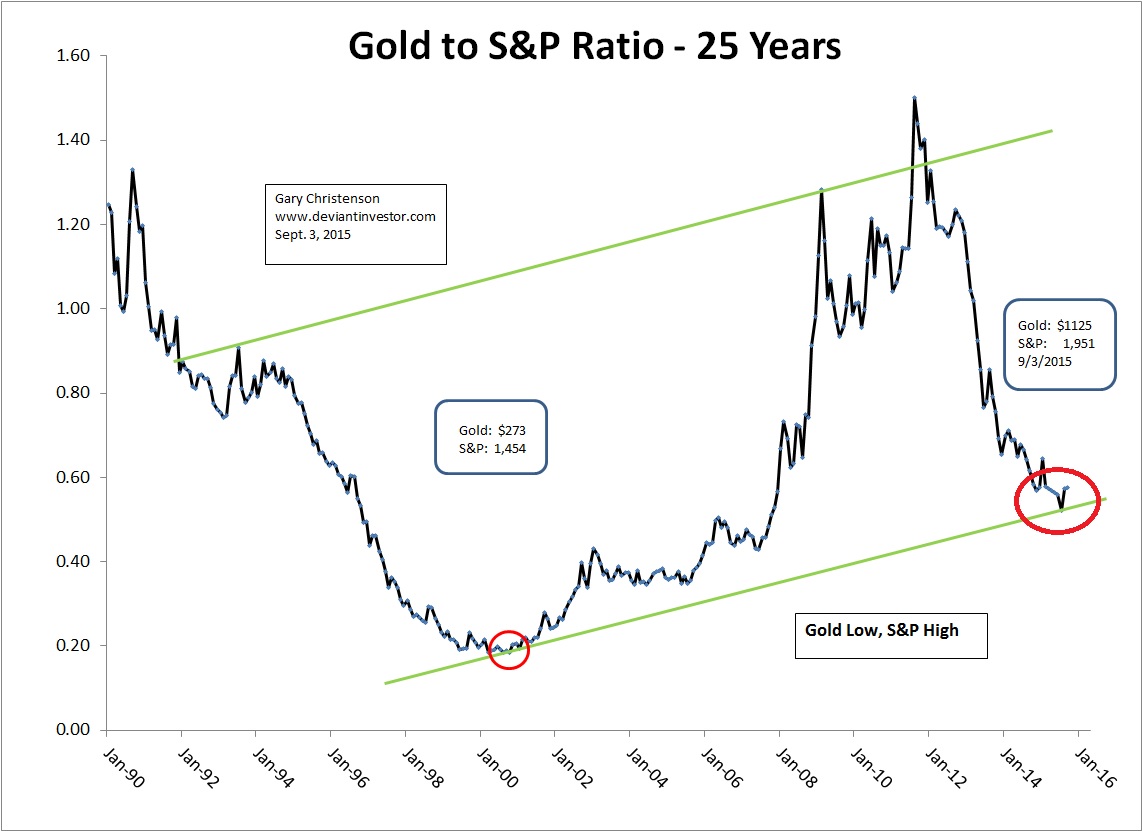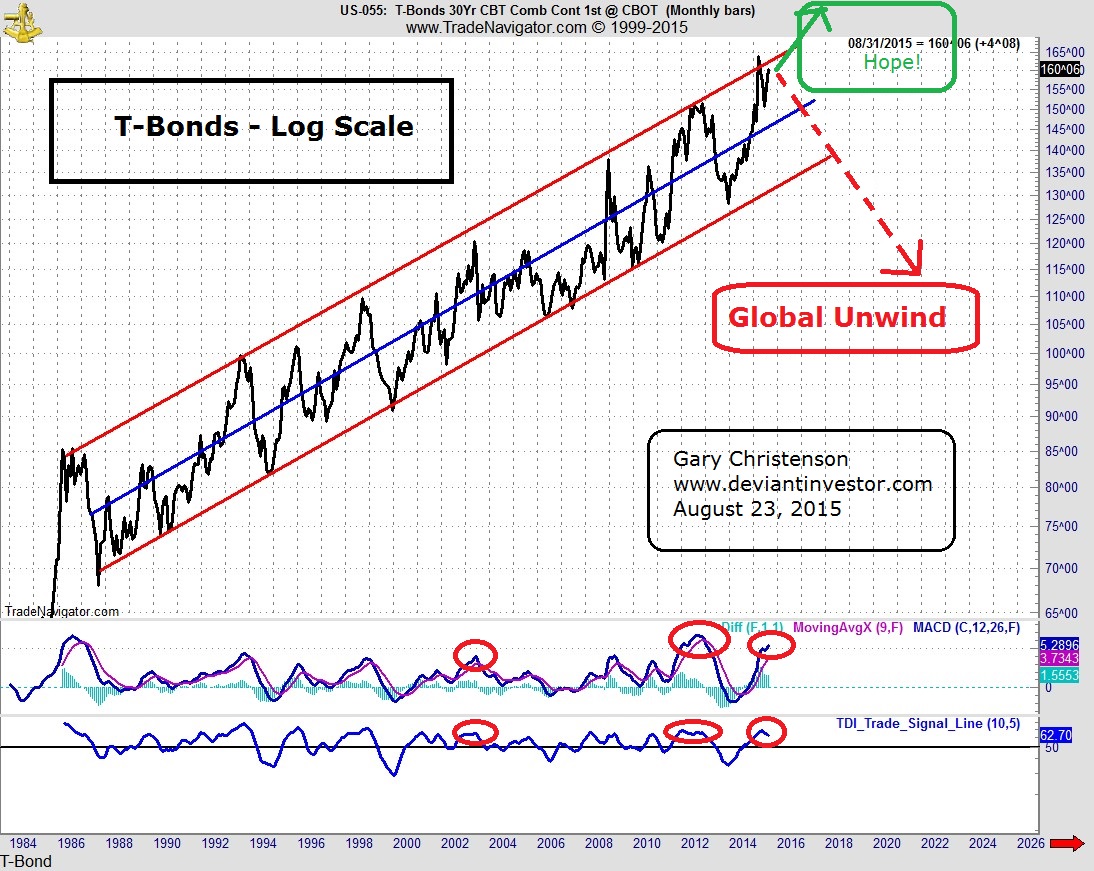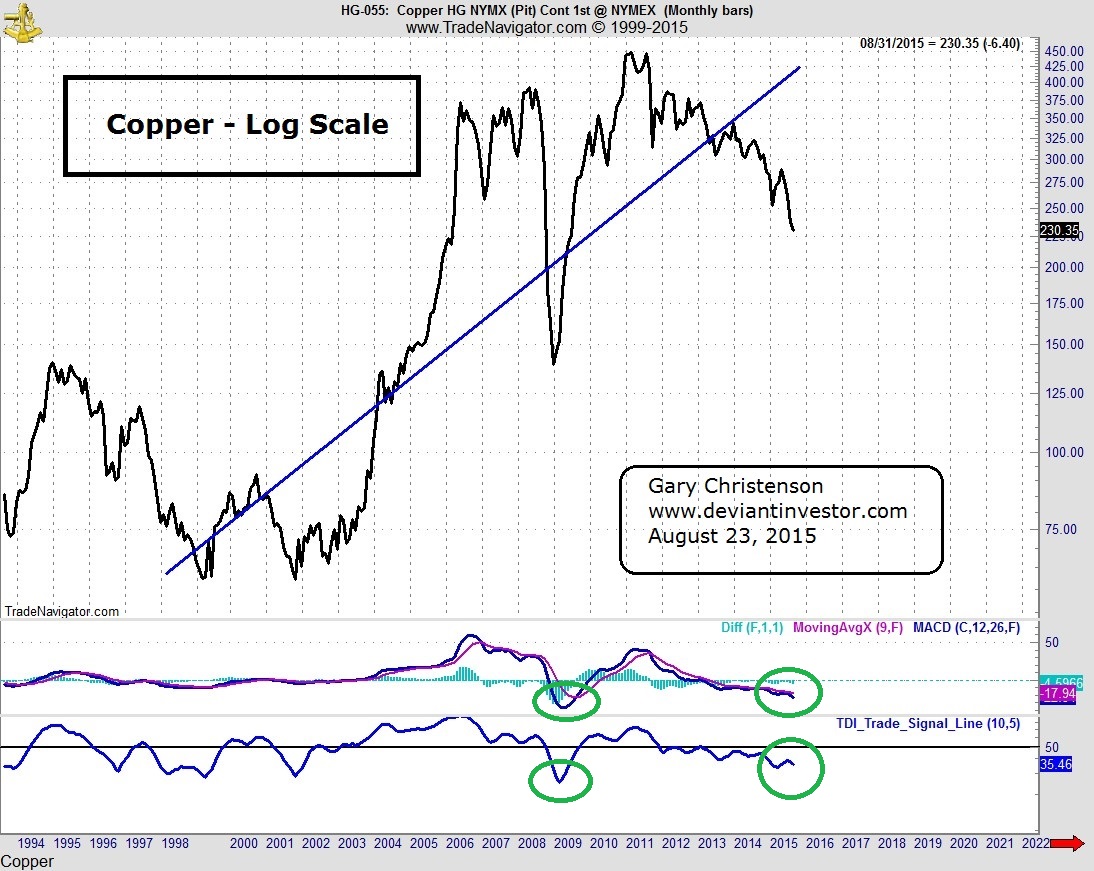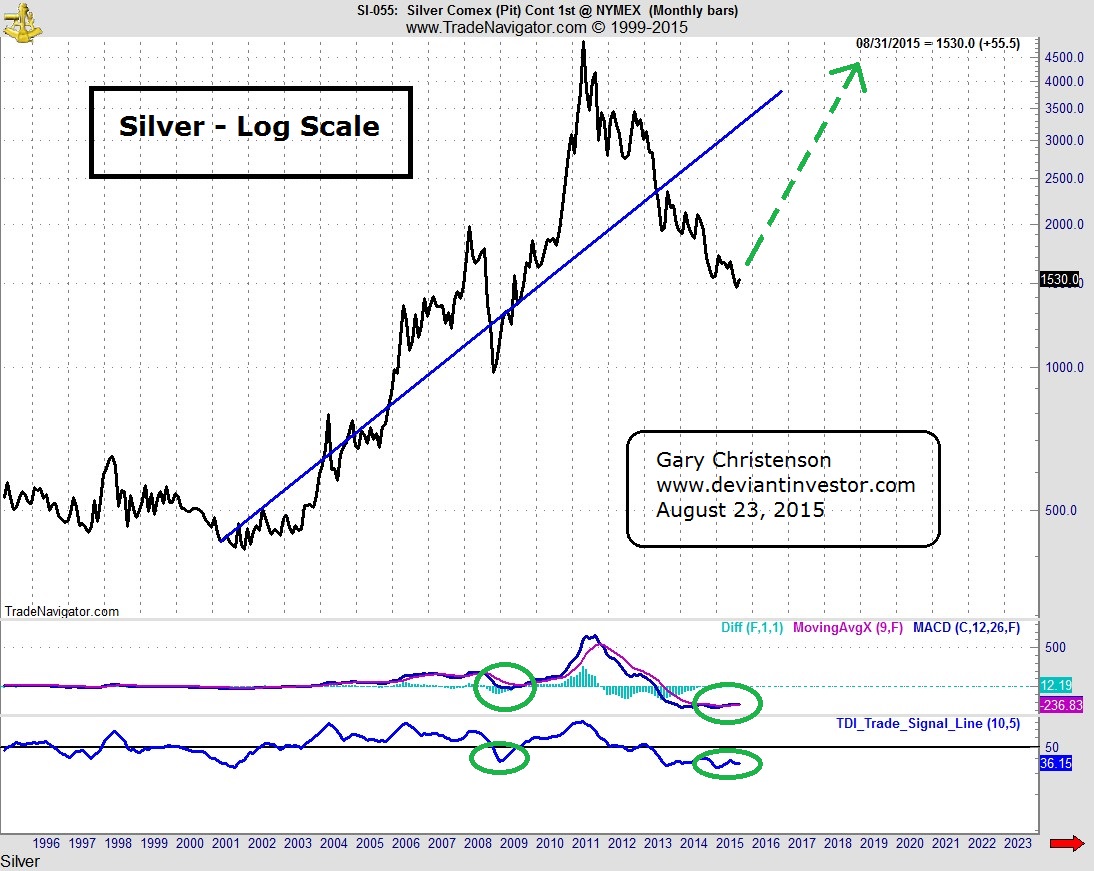Gold & Precious Metals
Buy Gold, Sell the S&P
Posted by Gary Christenson - The Deviant Investor
on Thursday, 10 September 2015 17:41
Buy low, sell high! As of today, September 3, 2015, the better choices are buying gold and selling the S&P 500 Index and relevant stocks.
Why?
Examine the graph of the ratio of Gold to S&P 500 Index for the past 25 years. The ratio is low now and likely will correct higher. I think gold will move higher and the S&P will move lower.

Examine the graph of the S&P – 20 years on a log scale. The Index has broken the red support line dating back to 2009. This is a “danger zone.” In addition, internals are weak, moving averages have turned lower and crossed each other, and some global stock markets have already crashed. I think it is likely the S&P moves much lower in the next six months.

Examine the graph of Gold – 20 years on a log scale. The three trend lines, as I have drawn them, show that gold is at the low end of the range and over a third lower than the center line which indicates the average of the long term exponential trend upward. I think gold will climb much higher in the next several years, and that the gold low in July will hold.

Could the S&P burst higher and gold be crushed again? Certainly! “Print” a few trillion dollars of digital “money” and buy S&P futures while selling short gold contracts and the S&P will levitate while paper gold prices drop. But is that likely?
My estimation is that various forces will nudge the S&P higher and occasionally levitate it, but deflationary forces will overwhelm both markets and central banks, and global stock markets will continue their downward path. Eventually people and investors will realize that “money” is now debt owed by a government, central bank or corporation that may not be solvent. When confidence in the viability of debt based fiat currencies and confidence in the ability to repay debt diminishes, people will flock to gold investments.
My estimation: S&P down for months, maybe several years, and gold up for years! If not, then these (no longer relevant) ideas may still be true:
- Buy stocks for the long term. They always go up.
- Buy real estate – house prices always go up.
- Gold is useless and a relic of the past.
- Don’t fight the Fed.
- Trust Wall Street brokers as they have your best interests at heart.
- Politicians will take care of the middle class.
- Hope and change.
These are my opinions. Do you own analysis and make your own choices.
Test:
- How much gold should you own knowing that the Federal Reserve is in charge of the money supply?
- How much gold should you own knowing that gold protects purchasing power and central banks want to devalue their currencies?
- How much gold should you own knowing that consumer prices rise during times of war?

Big Cap PM Mining Stocks Cannot Go Lower…Can They ?
Posted by Rambus Chartology
on Tuesday, 8 September 2015 13:30
In this Weekend Report I’m going to take an indepth look at some the individual precious metals stocks so we can see where they’re at from a short to long term perspective. We’ll start by looking at some of the more important big cap PM stocks as the precious metals stock indexes can’t have a significant rally until this group is ready to run. Anything can happen in the very short term but the further you go out in time the less likely the big trend is going to change on a dime.
The first stock we’ll look at will be a daily chart of the ABX which is one of the biggest of the big caps. From late last year to July of this year ABX built out a shallow bear flag consolidation pattern. The breakout led to our most recent lows around the 6.50 area. Last Friday it gapped below the bottom black dashed S&R line and backtested it at the end of the day. So on the very short term time frame ABX is testing overhead resistance at 6.50.
The long term weekly chart shows the massive H&S top ABX built out that reversed its bull market reversing the uptrend into a downtrend as shown by all the consolidation patterns. The close on Friday marked the lowest closing price since the bear market started in 2011 which is a milestone in its own right. You can see how the blue bear flag on the daily chart above fits into the bear market downtrend.
The 20 year monthly chart shows the massive inverse H&S bottom ABX built out in the late 1990’s – earlier 2000’s which led to its bull market run. That major low came in around eleven. What this chart so clearly shows is that ABX has now taken out the major low in 2008 and now the other major low at the bear market bottom in the late 1990’s. Note how the recent blue bear flag formed right on that important bottom rail in the 1990’s signalling that if it broke to the downside new lows would quickly follow. As you can see ABX has been in free fall since the break below the bottom rail of the blue bear flag and the horizontal support and resistance line at eleven. This move down could very well mark the capitulation move is underway.
Now that you have the idea, in this great Weekend report there are 11 more charts analysed just Go HERE – Money Talks Ed

Gold-Silver Ratio in Gear
Posted by Gary Tanashian - NFTRH
on Friday, 4 September 2015 14:55
Now that the US stock market has gotten in sync with the rest of the world in its ups and downs, it also joins the rest of the world in generally (and loosely; it’s not a minute-by-minute relationship) being inverse to the Gold-Silver ratio (GSR, AKA the “metallic credit spread” – Hoye).
Here is the daily view of the GSR, showing a gap up and spike that came with the stock market’s big disturbance and a consolidation down that has come with its relief bounce. This is a bullish chart and so, it is a short-term bearish chart for US and global stocks. GSR broke out and is bullish while above the MA 50’s, MACD and RSI are positive and AROON is trend up.

GSR weekly is fully bullish as well. It adds a long-term up trend to the daily chart’s bull features. You can see the long and grinding journey upward GSR has taken since it was drubbed in 2010 (into 2011) by full frontal QE, as silver exploded vs. gold and the ‘inflation trade’ took off in 2010 and eventually blew out (in spring of 2011).

GSR monthly offers a different view however, as it is nearing historical resistance. Maybe when this resistance is hit it will hold and those who have, shall we say cheered so long and hard for silver can finally deliver the ultimate “I told you so!” after 4+ years of futility.

The bottom line is that the Gold-Silver ratio indicates more short-term problems in US and global stock markets, commodities and even potentially the precious metals themselves. But the bigger picture view at least offers a line in the sand (long-term resistance) where an ‘inflation trade’ may finally get going again.
That scenario could be the product of a saturation of the non-stop inflation that has been promoted in the US and globally by policy makers, with a global deflationary backdrop hiding its effects. Alternatively, it could be the product of panic by the US Central Bank, should the stock correction get serious enough. The entire recovery out of 2009 has been, after all, about risk ‘on’ asset market speculation and wealth effects.
Whatever it is, you can bet that political animals and powerful policy makers alike do not want to see the Gold-Silver ratio break out of its big picture limits.

Don’t Make This Gold Mistake
Posted by Offshore and Asset Protection
on Wednesday, 2 September 2015 19:08
 When I was a lad studying economics in between bouts of playing blues guitar, surfing, and drinking fine Namibian lager, professors taught my classmates and me the origins of paper money. Like the beginners we were, we Economics 101 students trusted and believed them.
When I was a lad studying economics in between bouts of playing blues guitar, surfing, and drinking fine Namibian lager, professors taught my classmates and me the origins of paper money. Like the beginners we were, we Economics 101 students trusted and believed them.
Years later, when I was a postgrad in Economic History, I learned that my professors were wrong. Their account of the origins of paper money was based on theoretical wishful thinking rather than real world history. When you studied actual events, you found that things weren’t so simple.
My professors believed what they were teaching to be true because it was an elegant and logical explanation, and because their professors had taught it to them. That same trust in elegance and logic characterizes many people today when it comes to owning gold.
That’s a big mistake.
Paper Isn’t Metal
The standard explanation of the origins of paper money sounds plausible, but it isn’t the whole — or even the main — story.
In the old days, the wise greybeards explained, money always took the form of a precious metal, usually gold. People would exchange gold coins for goods and services. That meant they had to carry those coins around with them, which was dangerous. So goldsmiths started offering secure storage services for a small fee.
It was a hassle to go to the goldsmith every time you needed to transact, so the smiths started issuing paper certificates of deposit in various denominations. In theory, every piece of this paper was fully backed by gold stored with a smith somewhere, and you could go get it if you wanted. The certificates derived their value from the underlying value of gold.
People used these certificates to transact — and voila, paper money (and banking) was born.
This scenario may have played out in some places, but the historical record suggests that paper money actually rose independently at various times around the world through quite a different mechanism. Paper money (and other forms like cowrie shells and tally sticks) came into being as a way to measure and trade in debt. For long periods of human history, people understood that money was a claim on someone else’s obligation to provide goods or services, not on their gold. They accepted it because they knew that everybody else did the same thing … especially the taxman.
The ETF Scam
Fast forward thousands of years, and people still confuse paper and metal. This is especially true when it comes to exchange-traded gold funds (ETFs) like GLD.
Like the goldsmiths of old, gold ETFs claim to have gold in secure storage, and sell pieces of paper that they say represent them. These pieces of paper can be traded and vary in price with the underlying price of gold.
At first blush, this seems like a cheap and convenient way to “own” gold. The problem is that in an ETF you don’t own any gold at all.
Most ETFs are organized as trusts. If you read the GLD prospectus carefully, you’ll note that your investment is actually in “fractional, undivided beneficial ownership interests in the trust, the sole assets of which are gold bullion, and, from time to time, cash.” In other words, you own a piece of debt issued by the trust that runs GLD, not gold itself. And some of that debt may represent “cash,” not gold.
Now, you can’t convert that piece of trust-issued debt into physical gold except with the permission of the trust … and that permission is only given if you want to cash out at least 100,000 shares, which are worth about $13 million at the moment. And even then, you don’t have the right to any actual gold; the trust retains the right to substitute “cash” — once again.
Of course, since your interest in the GLD ETF is a “fractional” financial interest in the trusts’ assets, not your own gold, it’s fully reportable to the IRS as a financial account, even if you own GLD shares via an overseas vehicle like an LLC or trust of your own.
And since the GLD trust is structured as a “grantor” trust, you pay taxes on its underlying assets — the gold you don’t actually own — at a long-term holding at a rate of 28%, instead of the 15% capital gains tax you would pay on an equity holding alone, like your share in the GLD trust.
A Golden No-Brainer
Nobody really knows whether the gold underlying the GLD ETF is all there. They say it is, but it’s stored in a HSBC vault in London along with HSBC’s own gold, as well as metal belonging to others. Who knows how it gets moved around?
“Owning” gold via an ETF is a lot like paper money. It’s basically just a claim on someone else’s debt, just like those ancient forms of money. And just like any other debt claim, you have to take it on trust that it can be fulfilled.
If you’re not in the mood to trust someone you don’t even know, I’d suggest you invest in some real, actual gold.
Kind regards,
Ted Bauman
Offshore and Asset Protection Editor

Silver and Warnings From Exponential Markets
Posted by Gary Christenson - The Deviant Investor
on Monday, 31 August 2015 16:31
For the past 15 – 40 years, debt and prices in most markets have moved upward, broadly speaking, in exponential trends. See the following log-scale graphs.
US T-Bonds: T-Bonds have been rallying in their bull market since the early 1980’s. Will they continue, correct, or crash? Doug Noland says it is “The Beginning of the Great Global Unwind.” See chart.
“I really fear for the unwind of the ‘global government finance Bubble’ – the grand finale of a multi-decade period of serial bubbles. It’s history’s first systemic global Bubble, encompassing the world’s Credit systems, securities markets and monetary systems more generally.”
Corn: Since the late 1990s corn prices have increased in an erratic exponential pattern. Corn prices are currently way below trend. Deflationary forces push it downward but devaluation of currencies will push it upward.
Dr. Copper: It has the same basic pattern as corn and sugar (not shown).
Silver: Silver prices increased exponentially since 2001, peaked in April 2011 at more than double the exponential trend price (as drawn), and crashed to about half the exponential trend price.
The Message from the Markets:
Paper markets such as T-Bonds and the S&P 500 have been levitated by central bank “money printing,” government support, and the inevitable devaluation of fiat currencies built into the structure of the financial system. Paper markets move higher – exponentially – as currencies devalue and reset or crash to lower levels, and then repeat.
“Buy for the long term” works if you buy the lows and lighten up at the highs. Few people succeed. NOW is NOT the time to buy most stocks, while NOW is the time to buy silver and gold. However, few people will transfer their digital currencies into physical metal, and most will regret not doing so.
Commodity markets increase in price due to the same devaluation of currencies that propels paper markets higher. They also fall when global economies weaken, or when countries manipulate commodity prices lower (e.g. crude oil) to damage the economies of enemies. These tactics have been used for decades – and will continue to be used by global governments.
But people and economies need commodities such as silver, copper, crude oil, and sugar. Devaluations, manipulations, supply, demand, taxes, HFTers, and government legislation can push prices far higher and lower for years. Perhaps some commodity prices will stay low for a while longer, but remember:
- Central banks heavily influence the supply of money and will inflate their currencies. The exponential increases in prices will continue unless we devolve into a deflationary depression that overwhelms the considerable efforts of central banks to inflate.
- Central banks fear deflationary forces and will inflate and devalue their currencies to avoid deflation.
- Politicians will spend and borrow, and create exponentially increasing debt which increases the money supply and devalues their currencies.
- Silver and gold act like commodities but also as monetary metals. When economies, stock markets, and bond markets become unstable due to excess leverage and overly optimistic valuations (like now), when people, hedge funds, and institutions become fearful, they want real assets, like gold and silver, not debt based paper that can devalue rapidly. A trickle of demand for silver and gold can quickly become a flood based on fear and worry.
GENERAL CONCLUSIONS:
Economic policies that devalue currencies and create inflation … will create inflation. Yes, it is stupid but central banks and governments everywhere use the same flawed thinking. How are those policies working for people in Venezuela, Argentina, and Ukraine today? Is it conceptually different in Greece, Russia, the UK, Japan, or the US?
Silver prices are currently low compared to global debt, CEO bonuses, government spending, official US national debt, the S&P 500 Index, silver prices in 2011, money in circulation, gold prices, military spending, pension underfunding, and the prices of college tuition and health care. Silver prices will increase substantially in the next five years.
If a government subsidizes butter, it will get more butter. The US government, and many others, currently subsidize social welfare spending, food stamps (SNAP), poverty, disability income, corporate welfare, military adventures, dependence upon government, media propaganda, financial corruption, medical expenses, Medicare, congressional corruption, and so much more. Expect more of the same. The consequences of most of the above will directly or indirectly increase silver prices over the next five years.
Thought Experiment: Place a few assets in a virtual time capsule that you will open in the year 2020. Do you want gold coins, silver bars, paper dollar bills, a stock index ETF certificate, a junk bond issued by an insolvent “fracking” company, Apple stock certificates, Venezuela Bolivars, Russian Rubles, junk silver coins, or Hillary 2016 campaign buttons? In 2020 we will recognize that the value of silver coins, silver bars, and gold coins has increased substantially compared to the other options.
Invest and purchase financial insurance, such as silver and gold, accordingly.
Read: Steve St. Angelo: When the Global Silver Shortage Arrives
Deviant Investor: Gold and Exponential Markets Warning
Chris Martinson: Making Sense of the Plunge


-
I know Mike is a very solid investor and respect his opinions very much. So if he says pay attention to this or that - I will.
~ Dale G.
-
I've started managing my own investments so view Michael's site as a one-stop shop from which to get information and perspectives.
~ Dave E.
-
Michael offers easy reading, honest, common sense information that anyone can use in a practical manner.
~ der_al.
-
A sane voice in a scrambled investment world.
~ Ed R.
Inside Edge Pro Contributors

Greg Weldon

Josef Schachter

Tyler Bollhorn

Ryan Irvine

Paul Beattie

Martin Straith

Patrick Ceresna

Mark Leibovit

James Thorne

Victor Adair







